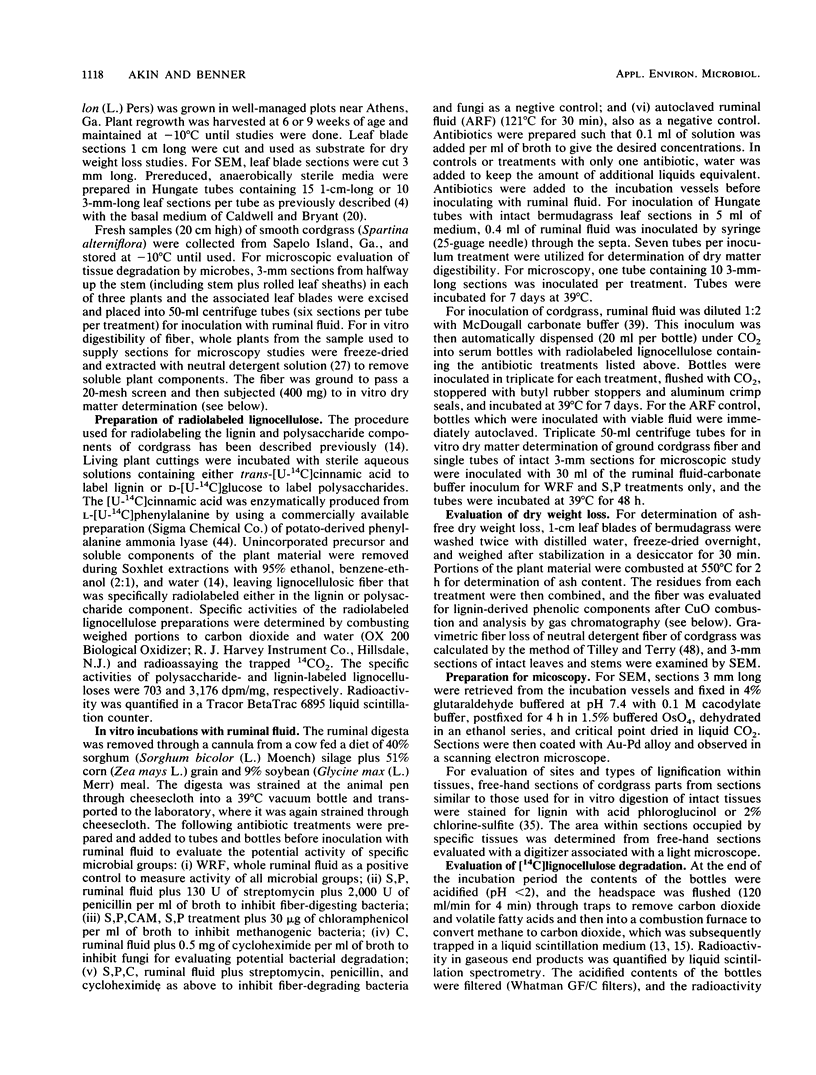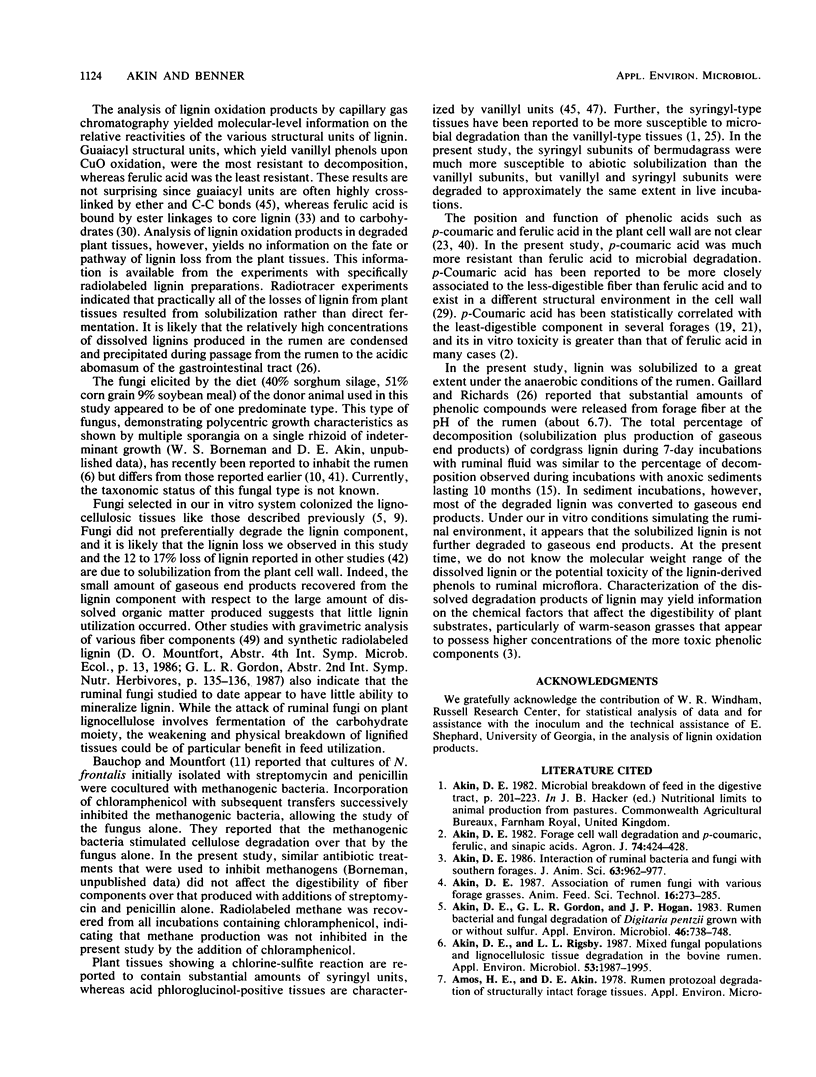Abstract
Bermudagrass (Cynodon dactylon) leaf blades and whole cordgrass (Spartina alterniflora) fiber were evaluated for degradation of cell walls by microbial groups in ruminal fluid. The groups were selected by the addition of antibiotics to the inoculum as follows: (i) whole ruminal fluid (WRF), no antibiotics; (ii) cycloheximide (C) to inhibit fungi, thus showing potential bacterial activity; (iii) streptomycin and penicillin (S,P) to inhibit fiber-degrading bacteria, showing potential fungal activity; (iv) streptomycin, penicillin, and chloramphenicol (S,P,CAM) to inhibit all bacteria including methanogens; (v) streptomycin, penicillin, and cycloheximide (S,P,C) to inhibit all microbial activity as a control; and (vi) autoclaved ruminal fluid (ARF) to inhibit all biological activity as a second control. Scanning electron microscopy of tissue degradation indicated that tissues not giving a positive histological reaction for lignin were more readily degraded. Cordgrass was more highly lignified, with more tissues resisting degradation than in bermudagrass. Patterns of degradation due to treatment resulted in three distinct groups of data based on the extent of fiber or component losses: WRF and C greater than S,P and S,P,CAM greater than S,P,C and ARF. Therefore, bacterial activity was responsible for most of the fiber loss. Fiber degradation by anaerobic fungi was significantly less (P = 0.05). Cupric oxide oxidation of undigested and digested bermudagrass fiber indicated that phenolic constituents differed in their order of resistance to removal or solubilization. Vanillyl and syringyl components of lignin were the most resistant to decomposition, whereas ferulic acid was readily solubilized from fiber in the absence of microbial activity.(ABSTRACT TRUNCATED AT 250 WORDS)
Full text
PDF








Images in this article
Selected References
These references are in PubMed. This may not be the complete list of references from this article.
- Akin D. E., Gordon G. L., Hogan J. P. Rumen bacterial and fungal degradation of Digitaria pentzii grown with or without sulfur. Appl Environ Microbiol. 1983 Sep;46(3):738–748. doi: 10.1128/aem.46.3.738-748.1983. [DOI] [PMC free article] [PubMed] [Google Scholar]
- Akin D. E., Rigsby L. L. Mixed fungal populations and lignocellulosic tissue degradation in the bovine rumen. Appl Environ Microbiol. 1987 Sep;53(9):1987–1995. doi: 10.1128/aem.53.9.1987-1995.1987. [DOI] [PMC free article] [PubMed] [Google Scholar]
- Amos H. E., Akin D. E. Rumen protozoal degradation of structurally intact forage tissues. Appl Environ Microbiol. 1978 Sep;36(3):513–522. doi: 10.1128/aem.36.3.513-522.1978. [DOI] [PMC free article] [PubMed] [Google Scholar]
- Bauchop T., Mountfort D. O. Cellulose fermentation by a rumen anaerobic fungus in both the absence and the presence of rumen methanogens. Appl Environ Microbiol. 1981 Dec;42(6):1103–1110. doi: 10.1128/aem.42.6.1103-1110.1981. [DOI] [PMC free article] [PubMed] [Google Scholar]
- Bauchop T. Rumen anaerobic fungi of cattle and sheep. Appl Environ Microbiol. 1979 Jul;38(1):148–158. doi: 10.1128/aem.38.1.148-158.1979. [DOI] [PMC free article] [PubMed] [Google Scholar]
- Benner R., Hodson R. E. Thermophilic anaerobic biodegradation of [C]lignin, [C]cellulose, and [C]lignocellulose preparations. Appl Environ Microbiol. 1985 Oct;50(4):971–976. doi: 10.1128/aem.50.4.971-976.1985. [DOI] [PMC free article] [PubMed] [Google Scholar]
- Benner R., Maccubbin A. E., Hodson R. E. Anaerobic biodegradation of the lignin and polysaccharide components of lignocellulose and synthetic lignin by sediment microflora. Appl Environ Microbiol. 1984 May;47(5):998–1004. doi: 10.1128/aem.47.5.998-1004.1984. [DOI] [PMC free article] [PubMed] [Google Scholar]
- Benner R., Maccubbin A. E., Hodson R. E. Preparation, characterization, and microbial degradation of specifically radiolabeled [C]lignocelluloses from marine and freshwater macrophytes. Appl Environ Microbiol. 1984 Feb;47(2):381–389. doi: 10.1128/aem.47.2.381-389.1984. [DOI] [PMC free article] [PubMed] [Google Scholar]
- Bryant M. P. Nutritional requirements of the predominant rumen cellulolytic bacteria. Fed Proc. 1973 Jul;32(7):1809–1813. [PubMed] [Google Scholar]
- Caldwell D. R., Bryant M. P. Medium without rumen fluid for nonselective enumeration and isolation of rumen bacteria. Appl Microbiol. 1966 Sep;14(5):794–801. doi: 10.1128/am.14.5.794-801.1966. [DOI] [PMC free article] [PubMed] [Google Scholar]
- Gaillard B. D., Richards G. N. Presence of soluble lignin-carbohydrate complexes in the bovine rumen. Carbohydr Res. 1975 Jun;42(1):135–145. doi: 10.1016/s0008-6215(00)84106-3. [DOI] [PubMed] [Google Scholar]
- Groleau D., Forsberg C. W. Cellulolytic activity of the rumen bacterium Bacteroides succinogenes. Can J Microbiol. 1981 May;27(5):517–530. doi: 10.1139/m81-077. [DOI] [PubMed] [Google Scholar]
- Kudo H., Cheng K. J., Costerton J. W. Interactions between Treponema bryantii and cellulolytic bacteria in the in vitro degradation of straw cellulose. Can J Microbiol. 1987 Mar;33(3):244–248. doi: 10.1139/m87-041. [DOI] [PubMed] [Google Scholar]
- McDougall E. I. Studies on ruminant saliva. 1. The composition and output of sheep's saliva. Biochem J. 1948;43(1):99–109. [PMC free article] [PubMed] [Google Scholar]
- Morrison I. M. Structural invesiigations on the lignin-carbohydrate complexes of Lolium perenne. Biochem J. 1974 Apr;139(1):197–204. doi: 10.1042/bj1390197. [DOI] [PMC free article] [PubMed] [Google Scholar]
- Orpin C. G. Isolation of cellulolytic phycomycete fungi from the caecum of the horse. J Gen Microbiol. 1981 Apr;123(2):287–296. doi: 10.1099/00221287-123-2-287. [DOI] [PubMed] [Google Scholar]
- Orpin C. G. Studies on the rumen flagellate Neocallimastix frontalis. J Gen Microbiol. 1975 Dec;91(2):249–262. doi: 10.1099/00221287-91-2-249. [DOI] [PubMed] [Google Scholar]
- Stafford H. A. Histochemical & Biochemical Differences Between Lignin-Like Materials in Phleum pratense L. Plant Physiol. 1962 Sep;37(5):643–649. doi: 10.1104/pp.37.5.643. [DOI] [PMC free article] [PubMed] [Google Scholar]
- Windham W. R., Akin D. E. Rumen fungi and forage fiber degradation. Appl Environ Microbiol. 1984 Sep;48(3):473–476. doi: 10.1128/aem.48.3.473-476.1984. [DOI] [PMC free article] [PubMed] [Google Scholar]









